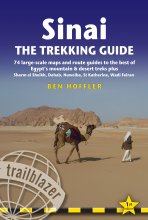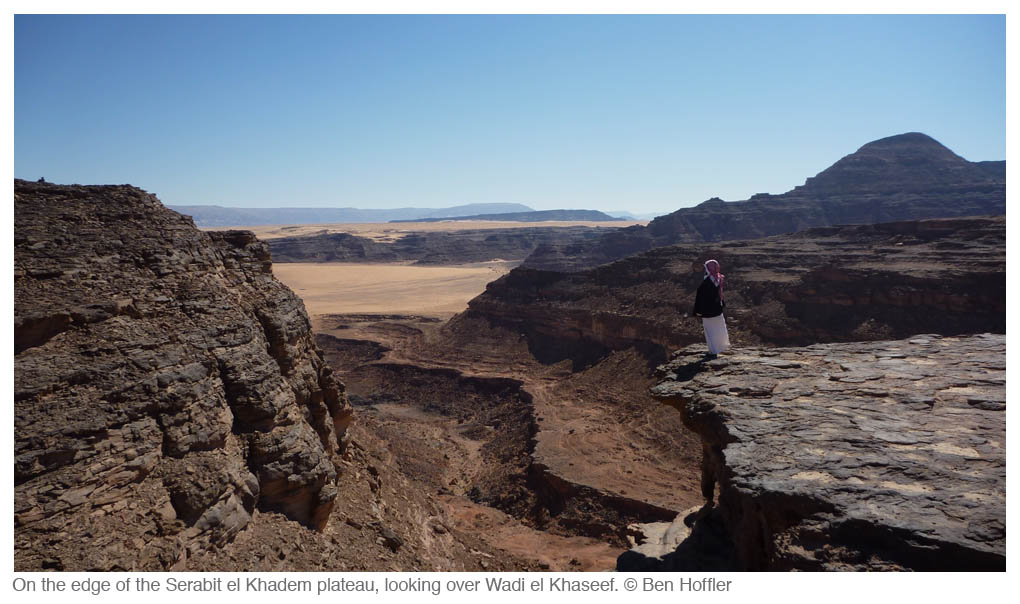'These human-scale books, written and published by people who genuinely know and love their subject, are perfect for travel's post-pandemic recovery.'
— The Guardian, March 2021

Sinai - The Trekking Guide
Excerpt:
Planning your trek
Contents | Introduction | Planning your trek | When to go | Route options | Sharm el Sheikh | High Mountain Region | Sample trek: Jebel Berqa | Sinai desert trekking routes map
With a group or on your own?
No man can live this life and emerge unchanged. He will carry, however faint, the imprint of the desert, the brand which marks the nomad; and he will have within him the yearning to return, weak or insistent according to his nature. For this cruel land can cast a spell which no temperate clime can match.
Wilfred Thesiger Arabian Sands

BEDOUIN TRIBES AND TREKKING
The Bedouin are a tribal people and the Sinai has many different tribes. Each tribe has its own territory and most rule that trekkers need guides within it. It’s also usually specified that the guide must be one of their own tribesmen. In the High Mountain Region of the Jebeleya tribe, you need a Jebeleya guide. In Wadi Feiran, guides have to be from the local Gararsha tribe and so forth. Everything is outlined in the relevant trekking chapters. This guide requirement goes back centuries; before trekkers, traders, pilgrims and explorers had to take them too. Guiding is one of the few ways the Bedouin have been able to make a living out of their land; it’s not a modern-day money-making scheme rolled out purely for tourism.
TREKKING WITH A GUIDE
Don’t have any concerns about a guide limiting your independence on trek. The Bedouin are a fiercely independent people and a good guide will understand exactly what it is to want freedom in a wild place. Going with a guide means you don’t have to think about the humdrum practicalities that’d constrain you anyway. Guides do much more than just keep you on the right track too. They tell you about wildlife and history, explain place names, local legends and Bedouin culture. The whole trek is enriched.
The Bedouin make trekking in the Sinai what it really is; without them, you’d miss something essential. Guides can become companions who live as long in the memory as the scenery does.
Finding a guide yourself
Guides are found easily at trailheads: ask around and you’ll be pointed the right way. They influence treks more than anything so always choose carefully. Chat with any guide, getting a feel for his character and likely abilities. How well do you communicate? Does he seem reliable, knowledgeable and enthusiastic? As much as anything, will you get on? A lot of the time, success simply rests on an interpersonal dynamic. Remember, there’s no obligation to use the first guide you meet: if you don’t like one guide, find another. And if you get a bad feeling, heed it. Some so-called guides should be avoided at all costs.
Two more considerations are the route and schedule. Different routes may go between the same basic trekking highlights and they won’t necessarily be of equal merit. Trek names are specific to this book so they won’t tell guides all they need to know; detail the route by reading out key locations on the treks (they’re in bold section headers throughout the trek descriptions). As for schedules, these vary: you, your guide, the camels, the season and other things all have an effect. Some guides push for longer than you need; others rush to finish. The times in this book are just suggestions. It’s best to aim for couple of days’ flexibility either side, seeing how you go and adjusting accordingly from there.
Organising yourself is cheapest – but you have to haggle hard. In the desert the cheapest rates are about LE150/£15/US$25 per day, but LE200/£20/$35 is more standard (even for good hagglers). In St Katherine and Wadi Feiran, the minimum is about LE200/£20/US$35. Negotiate for an all-inclusive price that factors in guides, camels and food, plus extras such as jeeps (when needed). When a trek ends a few days from where it starts, you usually have to pay the guide for the return trip. As a rule of thumb, give one day’s extra pay for every three you’ve been on trail (eg if you’ve trekked six days, pay for an extra two). It’s common to pay half the money up front (your guide will buy food, camel fodder and a mountain of cigarettes), but never give the whole lot. Things can often be ready in a couple of hours if you’re alone. For groups of three or more, or for more complicated, remote treks, it might be the next day.
When do I need a camel?
Camels carry water, food and bags. They’re essential in the desert, where water is scarce (you’d struggle to get between wells carrying all your stuff). The mountains have more water, meaning treks can usually be done unsupported, at least over a couple of days. Camels become essential again on longer routes, when you need more supplies. Only one trek in this book has a village where you can re-stock on the way. Most of the time you have to carry everything needed from start to finish. Camels can also be good to ride (see box p81), especially on long, winding wadi treks. If you want a camel to ride as well as the one for baggage it’ll cost about LE100-200 per day (per camel). Take one per trekker; they walk about one-and-a-half times the pace of people – faster on sand – and if everyone rides the expedition can move at the same speed.
Guides and cameleers
These are usually distinct in the mountains. You go one way with a guide – often a more difficult way – as the camel takes another one, meeting you at a rendez-vouz in the evening. In the desert you stay with camels pretty much the whole way. Guides and cameleers are essentially one and the same thing here (this is one reason it’s often cheaper to trek in the desert).
Independent women
Harassment is common in Egypt and although it’s rare for women to have problems from Bedouin guides it’s not unknown. Single women should at least be extra selective in choosing a guide. Trekking with a friend can be the most comfortable option of all. See also pp56-7.
GROUP TOURS
Trekking tours are taking off in the Sinai and it’s easy to find an all-inclusive package with a trek, flights, transfers and accommodation. Most packages focus on the best-known trails in the High Mountain Region or the desert, sometimes throwing in excursions to Cairo or Upper Egypt. There are benefits: there’s no hassle with organisation, expeditions are more comfortable and medical know-how is usually better. You get the social benefit of meeting like-minded others too. The downsides are the rigid schedules, limited independence and lack of genuine, spontaneous contact with the local culture. Whether you’d like one just depends on your travel philosophy. Typical prices range from £800 to £1200 for a 10-day package and sometimes more.
TREKKING AGENCIES
Many of the trekking agencies in the Sinai are run by Bedouin. Use them to organise anything from a guide to a jeep or an entire trek. They’re especially useful for long, complicated, or remote routes.
When organising with a Sinai-based company from home, don’t forget to haggle. Emails carry little of their culture; it’s easy to forget prices quoted will be deliberately high in the expectation you’ll negotiate. Drive the price down over several messages; there’ll almost always be leeway (see p48).
Trekking agencies based elsewhere in the world offer places in bigger, Western trekking groups. They work through local agencies like those listed for the Sinai but that’s not to say they’re exactly the same. These add value in bringing the big groups together in the first place and their know-how makes trips extra comfortable.
Sinai - The Trekking Guide
Excerpts:
- Contents
- Introduction
- Planning your trek
- When to go
- Route options
- Sharm el Sheikh
- High Mountain Region
- Sample trek: Jebel Berqa
- Sinai desert trekking routes map
Price: £14.99 buy online now…
Latest tweets